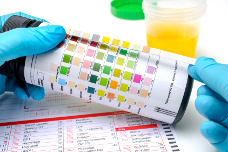Urine and stool tests
Author: Gesche Tallen, MD, PhD, Editor: Maria Yiallouros, Reviewer: Prof. Dr. med. Ursula Creutzig, English Translation: Hannah McRae, Last modification: 2012/03/19 https://kinderkrebsinfo.de/doi/e74938
Urinanalysis (UA)
contains an array of laboratory tests performed on urine and a frequently used tool in childhood cancer diagnostics. A part of a urinalysis can be performed by using so-called urine dipsticks, in which the test results can be read as color changes. Components, that are regularly determined in urine samples from children and teenagers with cancer are:
- Electrolytes, acids, alkalines, and proteins: to monitor the patient's fluid balance and kidney function
- Glucose (sugar): to monitor kidney function and detect potential overdosage of glucocorticoids during certain treatment phases
- Blood cells as indicators of an internal bleeding or urinary tract infection, respectively
- Infectious diseases parameters and pathogens: to find the source of an infection
- Tumour markers: substances, that can be elevated in case of a certain malignant disease. For example, the presence of certain hormones, the so-called catecholamines, in the urine is associated with neuroblastoma, a childhood cancer of the autonomous nervous system
Stool tests
are mainly performed to:
- determine pathogens for infectious diseases diagnostics
- to look for blood in order to early detect intestinal bleedings as a result of treatment-induced severe immunosuppression and anaemia

